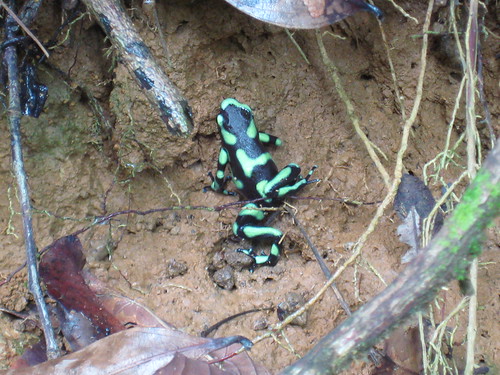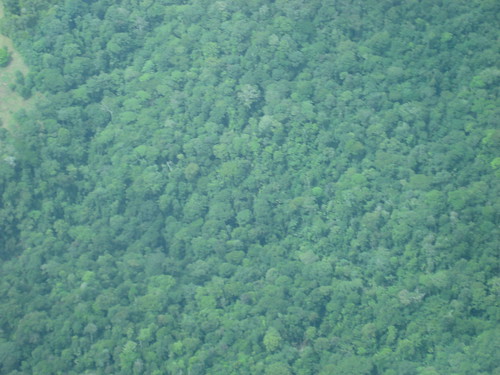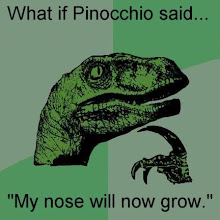 So as I mentioned in a previous post I recently got married, for our honeymoon my wife, still have a haven't gotten used to typing/saying that yet, and I went to Costa Rica [photo at left of a Green and Black Poison Dart Frog (Dendrobates auratus) by author]. There will be a couple of posts in the next few days about some things I found interesting/want to discuss about the country. I have two more posts that I have to finalize and I may be able to squeeze out one more but we will see. This post is going to serve more as an introduction to this little mini-series.
So as I mentioned in a previous post I recently got married, for our honeymoon my wife, still have a haven't gotten used to typing/saying that yet, and I went to Costa Rica [photo at left of a Green and Black Poison Dart Frog (Dendrobates auratus) by author]. There will be a couple of posts in the next few days about some things I found interesting/want to discuss about the country. I have two more posts that I have to finalize and I may be able to squeeze out one more but we will see. This post is going to serve more as an introduction to this little mini-series.As with everything I try to do here I will avoid politics as much as possible. This will be for 2 main reasons, the first being I just try to avoid politics in my posts as much as possible anyway (although I am sure some people may feel that my discussion on global warming is political and unfortunately it has to be to some degree) and the second and most important is that I know nothing about politics in Costa Rica. This all being said some of the topics I discuss will touch on some potentially political topics.
One other thing I am going to try to avoid is making this sound like an advertisement for the resort that my wife and I stayed at. This will be the only post that I will explicitly state the name of the hotel, as well as link to their website, and this is because I am going to openly admit upfront that I did not see much of the country so my posts will only be about the area that I know and I want to be honest with you about what I feel could be a potential bias*.
 So now that I am done with that (took much longer than I expected) lets talk a little bit about the country itself [photo at right taken flying over a forested area of Costa Rica by author]. Costa Rica is located in southern Central America south of Nicaragua and north, although more west since Central America makes a turn in Costa Rica, of Panama. The country is just a little bit smaller than the state of West Virginia in regards to square mileage (~20,000 sq mi/~51,000 sq km for Costa Rica to ~24,000 sq mi/~63,000 sq km) but it has more than double the population of West Virginia (~5 million for Costa Rica to ~2 million for West Virginia). As you can imagine this is a much greater population density for Costa Rica as compared to West Virginia but most of the population is located in one region of the county known as the central valley. This area is the area of the country where San Jose is located. This area should be great for farming due to the rich volcanic soil, see geology is important, while the areas outside of this used to be primarily rain forest which, as I will discuss in a future post, very quickly becomes poor farming environment. The country is highly mountainous, which for anyone who has driven through West Virginia will tell you is another similarity between these two places, and this can be explained by the geology of the area, which will be discussed in greater depth in a future post.
So now that I am done with that (took much longer than I expected) lets talk a little bit about the country itself [photo at right taken flying over a forested area of Costa Rica by author]. Costa Rica is located in southern Central America south of Nicaragua and north, although more west since Central America makes a turn in Costa Rica, of Panama. The country is just a little bit smaller than the state of West Virginia in regards to square mileage (~20,000 sq mi/~51,000 sq km for Costa Rica to ~24,000 sq mi/~63,000 sq km) but it has more than double the population of West Virginia (~5 million for Costa Rica to ~2 million for West Virginia). As you can imagine this is a much greater population density for Costa Rica as compared to West Virginia but most of the population is located in one region of the county known as the central valley. This area is the area of the country where San Jose is located. This area should be great for farming due to the rich volcanic soil, see geology is important, while the areas outside of this used to be primarily rain forest which, as I will discuss in a future post, very quickly becomes poor farming environment. The country is highly mountainous, which for anyone who has driven through West Virginia will tell you is another similarity between these two places, and this can be explained by the geology of the area, which will be discussed in greater depth in a future post.My wife and I only spent one night in San Jose we spent most of our time in another part of the country. The area we stayed in was known as the Osa Peninsula, which surprisingly has a very crappy Wikipedia page. The peninsula is the furthest southwestern point of the country and my wife and I stayed on the tip of the peninsula. This part of the country is one of the most important ecological places in the world and according to everyone I talked with while there as well as a couple of other sources (which I can't find now) call the area one of the most ecologically diverse places on the planet if you want to know more about the ecology of the Osa Peninsula I recommend the Wikipedia page on the Corcovado National Park.
We stayed at a hotel named Bosque del Cabo. This hotel was interesting in that our room was an individual little cabin like structure that sat right near the drop off for the Pacific Ocean. The overlook provided the opportunity to watch plenty of birds as well as a chance to see all four of the monkey species that live in Costa Rica. This hotel, like many others on Osa Peninsula, is what is known as an ecolodge. The ecolodges down there try to be as much a part of nature as they can while still providing luxury amenities. Most of the power was created using solar power, some appears to have been made using hydroelectric sources as well, each cabin had their own individual solar water heater, the resort is tries to recycle as much of their waste as possible, and most importantly the forest, with the exception of right around the cabins, is allowed to grow free which allows the chance for the wildlife to live free nearby and actually get extremely close to the cabins. If you are looking for a place to stay if you visit Costa Rica I recommend finding an ecolodge on the Osa Peninsula it is worth the cost, and I will give them one more shout out but I personally recommend Bosque del Cabo.
With the basic introduction out of the way, far longer than I wanted to write as well, the rest of the posts in this series will focus on topics that are more commonly seen on this blog, things like geology and conservation, so I hope you enjoy the mini-series.
*I will admit I don't think bias is the proper word choice but I can't figure out what would be so you will have to deal with my really narrow vocabulary!

No comments:
Post a Comment